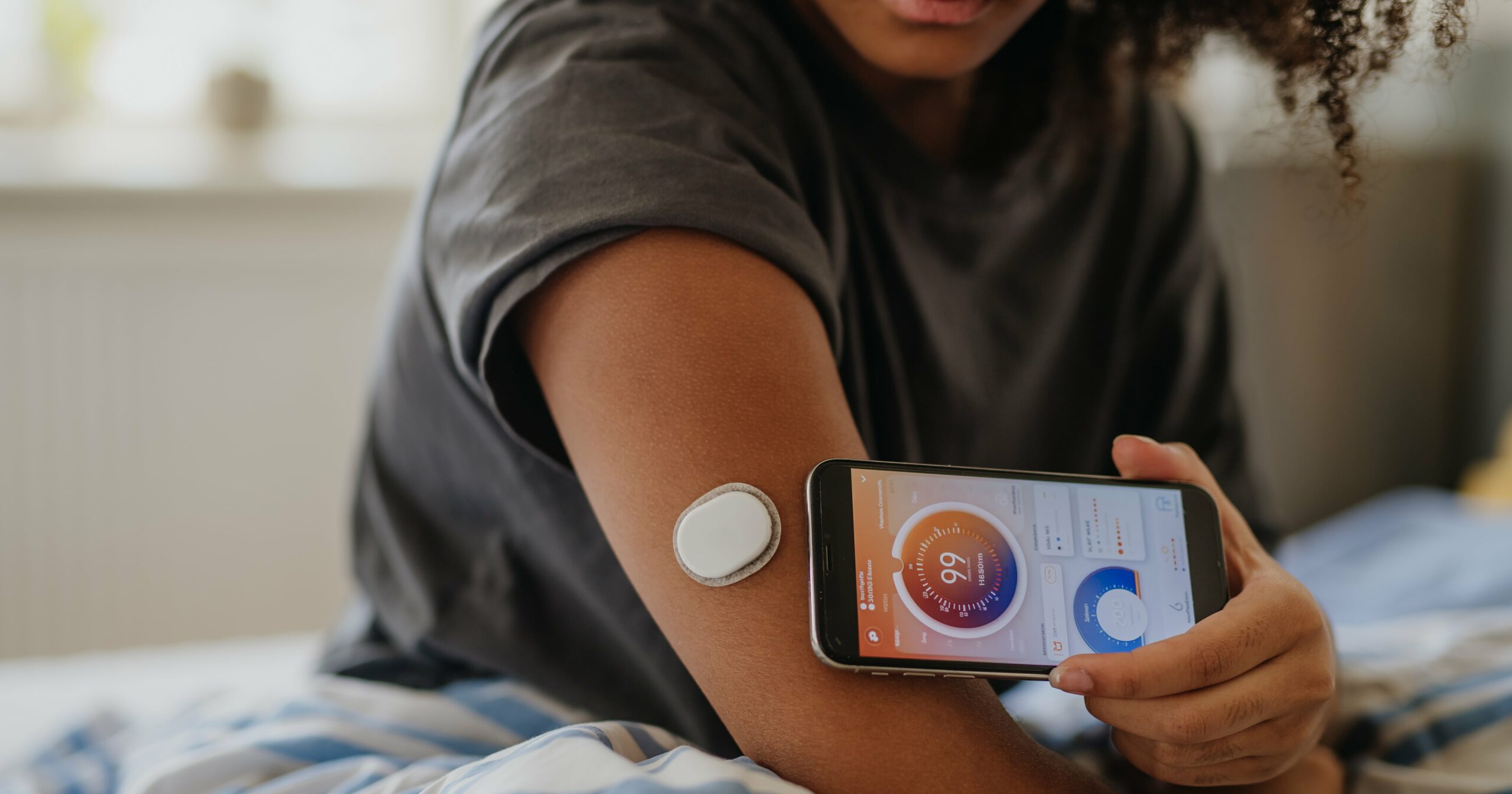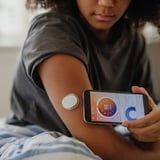For people with diabetes, blood sugar monitoring is one of the most important ways to maintain a healthy lifestyle. A continuous glucose monitor (CGM) is the most convenient option for replacing the traditional finger prick method, offering a small sensor underneath the skin that sends automated, real-time blood sugar readings straight to your smartphone.
This year, the FDA cleared the first over-the-counter CGM option that doesn’t require a prescription, which led to a surprising effect: Many of the people using them do not have diabetes.
Blood sugar tracking is rising in popularity among fitness experts and civilian health seekers alike, with many people eager to understand how glucose levels affect their nutrition, sleep, fitness, and overall wellness.
While experts agree that maintaining healthy blood sugar levels is beneficial for long-term health, the rise in CGM use among those without diabetes raises an important question: Is it really necessary to pay so much attention to your blood sugar if you don’t have a condition that requires it?
Here, we spoke with two experts to help us understand the benefits and risks of monitoring blood sugar without diabetes – and whether a CGM is a valuable tool, or an extra cost you may not actually need.
Experts Featured in This Article
Susan Spratt, MD, is a professor of family medicine and community health at Duke University.
Anthony Pick, MD, is an endocrinologist with Northwestern Medical Group specializing in innovation and technology.
What Is Blood Sugar?
Before diving into glucose monitoring, it’s helpful to understand the role of blood sugar in your body. “Blood sugar is the common name for blood glucose,” says Susan Spratt, MD. “Glucose is a molecule in our body – including our bloodstream, tissues like muscle, and organs like the liver and brain – that provides a substrate for energy.”
Blood glucose derives from the foods we consume, especially carbohydrate-rich options such as bread, pasta, and fruit. After eating, your body breaks these foods down into glucose, which enters the bloodstream and eventually into your cells, serving as your body’s primary energy source. Energy from glucose is necessary for the body to function, whether it’s for talking, thinking, moving, or digesting food.
“If you are perfectly healthy and do not have diabetes, you should not notice your blood sugar,” says Dr. Spratt. “Your body should work to digest and metabolize whatever food you eat to keep glucose [at] a normal level in your body, and you will never notice it.”
For those with diabetes, the body either does not produce enough or properly use insulin, a protein that helps move the glucose from your bloodstream into your cells, or both. This creates a challenge for the body to maintain healthy blood sugar levels. Diabetics monitor their blood sugar via finger prick tests or continuous glucose monitors to help them manage their symptoms and prevent blood sugar spikes or crashes, which can be dangerous and even fatal.
Should People Without Diabetes Monitor Their Blood Sugar?
There’s no question that continuous glucose monitoring is beneficial for people living with diabetes – but what about those who are not? From preventing the mid-day energy slump to optimizing workout performance, many people are embracing blood sugar monitoring to bolster daily life.
While blood sugar can affect energy levels, continuously tracking its highs and lows is not necessarily valuable to those without diabetes. Most recently, a study published in Diabetic Medicine found that CGMs are not well-suited to help improve metabolic health or prevent type 2 diabetes in those without the condition. Additionally, it revealed that the devices do not make much of a meaningful difference in long-term health if you’re using them for reasons other than diabetes management.
That said, there are a few instances in which experts may recommend tracking your blood sugar levels.
- If you think you might be at risk for diabetes or prediabetes: Anthony Pick, MD, explains that more than 8 in 10 people with prediabetes are unaware of their condition. He notes that normal fasting glucose is less than 100 milligrams per deciliter (mg/dL), whereas 101 to 125 mg/dL is considered prediabetes or impaired fasting glucose. Diabetes is diagnosed at 126 mg/dL and higher.
- To determine which foods spike your blood sugar: While fruit, pastries, candy, and other sugary items may be the obvious blood sugar triggers, they aren’t the only foods to cause a post-meal spike. A CGM device can help you determine which foods raise your glucose levels, allowing you to adjust your diet accordingly – especially if your fasting levels fall within the prediabetic range.
- To help optimize athletic performance: Whether you’re an endurance athlete or prefer high-intensity workouts, tracking your blood sugar can help determine the best ways to maximize performance and maintain energy. Low blood sugar (hypoglycemia) can lead to fatigue and dizziness, which negatively impacts physical activity. By monitoring your glucose levels, you can determine which exercises and foods affect fasting levels, making your workouts more efficient.
What Are the Risks of Blood Sugar Monitoring for Those Without Diabetes?
Utilizing blood sugar levels as a marker for overall health may not give you a thorough view, says Dr. Pick. “A CGM is only going to provide glucose levels, and those numbers alone do not provide the whole picture of your health,” he says. “There’s more to metabolism and wellness than glucose. In other words, you could be insulin resistant and have an unhealthy lifestyle [but] your glucose [levels] are not particularly abnormal.”
More importantly, he highlights that consuming unhealthy, hyper-processed foods may not necessarily affect your glucose levels. “Some foods may not spike your glucose, but [they] will still be very processed and unhealthy for you, so that’s the nuance in terms of not just being glucose-centric.”
Dr. Spratt also cautions that CGMs may confuse those unfamiliar with tracking blood sugar levels. “[They] are not 100 percent accurate, and unless you know how to interpret them, wearing one might cause unnecessary panic or anxiety about the numbers,” she says. “They are difficult to interpret without education or physician guidance.”
Misleading numbers can cause someone to believe their blood sugar has dropped dangerously low when, in reality, it hasn’t. “If patients have prediabetes or don’t have diabetes at all, they can [receive] false alarms that [their blood sugar is] low when it’s not,” Dr. Pick says. “And that tends to happen in the middle of the night when you’re lying on it, [causing a] compression of your blood sugar levels.”
He adds that a false low reading may compel people to reach for a snack in the middle of the night, resulting in unnecessary calories and sugar.
So, Should You Use a CGM to Track Blood Sugar?
Continuous glucose monitoring comes down to this: If you don’t have diabetes, you don’t need it. “If your BMI is under 25 and, unless you have diabetes or symptoms, I would not worry about glucose tracking,” says Dr. Spratt. “I would first recommend you talk to your doctor about being screened for diabetes. If you have prediabetes, [you can] attend a diabetes prevention program at your local YMCA.” An A1C blood test (typically done biannually) can also help determine your average blood glucose level and overall risk of developing diabetes.
Still, a key positive of glucose tracking for those without diabetes is the potential to become more mindful of lifestyle and food choices. For example, says Dr. Pick, “You say [to someone] you really don’t want to be eating that pizza, and then they actually wear a sensor and [realize] ‘Wow, my glucose really spiked above 200,’ which would be a considerable spike.”
He adds that those who don’t sleep well or feel extra stressed may also notice a glucose spike while wearing a CGM, triggering a focus on stress management and a better night’s rest. For athletes, CGMs may not be necessary in the long run, but they can provide a lot of initial insight when it comes to fine-tuning meals and training plans.
Regardless of the reason, it’s important to understand that glucose levels are just one piece of your overall health’s puzzle. Knowing the why behind the numbers is essential for getting the most value out of blood sugar monitoring.
“If you have people chasing noise and not understanding what they’re doing [and] responding to false alarms, I think you cause anxiety and potentially harm,” says Dr. Pick. “But if it leads to healthier behaviors, and people understand what the numbers mean, and we start to gather the data and have structure around it, that’s positive.”
Alex Vance is a freelance health and parenting writer featured in PS, Fortune Well, Today.com, BuzzFeed, Parents, Verywell Family, and more. Currently, she writes part-time for baby-tracking app Huckleberry and the health and fitness website Get Healthy U.




